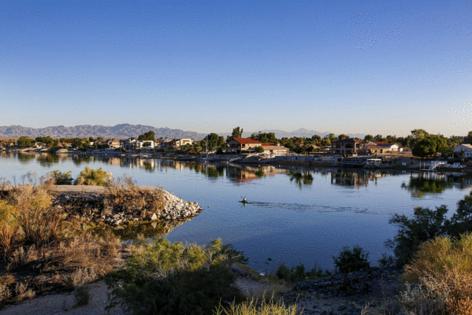Cancer-causing 'forever chemicals' abound throughout the American West, study finds
Published in News & Features
Many water managers have long been stumped on how to best control pesky, cancer-causing “forever chemicals” popping up in samples throughout the country.
In a first-of-its-kind water quality snapshot for all of the American West’s waterways, a team of researchers found out just how widespread the problem is. The peer-reviewed study evaluated levels of PFAS, or perfluoroalkyl and polyfluoroalkyl substances — compounds found everywhere in the 21st century, from food packaging to cosmetics.
Waterways from as far northwest as Washington state and as far southeast as New Mexico have at least some concentrations of PFAS chemicals of concern. Colorado River sampling was comparatively lower than most, as were the results from the Truckee River, Reno’s main water source.
The findings aren’t great news for public health, but more data is always better in evaluating the footprint of water contaminants, said Doug Sims, the study’s lead author and dean of the College of Southern Nevada’s School of Science, Engineering and Mathematics.
“PFAS is an endocrine disruptor, and when you’re looking at young kids as they grow up, it’s going to impact their development over time,” Sims said. “The more exposure that we have to these independent disruptors, the greater impact on the future health of individuals.”
The Biden administration’s Environmental Protection Agency finalized the country’s first enforceable contaminant standards in April to eliminate PFAS in drinking water, touting the prevention of thousands of deaths and the reduction of tens of thousands of serious illnesses.
Though there isn’t any call for concern for Lake Mead’s supply, the Silver State is one of the beneficiaries of federal funding pouring in to test and address the chemicals, with an ultimate goal of getting numbers down across the country.
“It’s clearly ubiquitous in the environment, and it’s not just being deposited into the natural environment by wastewater discharge,” Sims said. “It’s in the air. It gets into the clouds and rain, and is now being deposited into rivers.”
Colorado River sampling relatively low
The Southern Nevada Water Authority, the agency tasked with regulating the region’s water resources, has been tracking for PFAS since 2008 — far before they entered casual conversation, said Eric Dickenson, project manager for water quality and research and development.
Outside of the testing the agency already does, the new federal standard has prompted separate testing in Southern Nevada that will be completed at the end of this year, he said. All testing has been well below even the more conservative thresholds, he said, but PFAS are something the water authority has kept and will keep a close eye on.
“The regulatory landscape could change, so we’re going to be very proactive and keep monitoring for this very persistent suite of chemicals,” Dickenson said.
Southern Nevada sources about 90 percent of its water from Lake Mead, the nation’s largest reservoir, which is fed by the Colorado River. The study sampled Nelson’s Landing, Willow Beach and Yuma, Arizona, along the river, with one site as far north as Moab in Utah.
While some of the river’s sites tested for high levels of perfluorooctanoate, or PFOA, most of the Colorado River’s sampling indicated a clean bill of water health. But that luck won’t be forever, unlike the chemicals.
“With climate change lowering water levels, concentrations will go up,” Sims said.
Yeongkwon Son, an atmospheric sciences professor at Desert Research Institute and University of Nevada, Reno, said the results from Sims’ study were not cause for concern. However, what they do highlight is just how long PFAS stay in ecosystems.
“These contaminants stay much longer than we expected,” said Son, who was not involved in Sims’ study. “This is not surprising but still concerning.”
Federal regulations trickling down to Nevada
The federal regulations have ushered in a new wave of testing throughout the state, as well.
Andrea Seifert, chief of the state’s Bureau of Safe Drinking Water, said that between 2024 and 2027, Nevada will produce comprehensive testing results to evaluate how deep-rooted the PFAS issue is in different water sources.
“It wasn’t alarming,” Seifert said of Sims’ study. “It’s just additional information that helps us to understand our situation across the state.”
One water system, the Canyon General Improvement District in Storey County, is working with the state to upgrade infrastructure to address elevated levels of PFAS in its drinking water from the Truckee River, Seifert said. More mitigation measures may follow once testing is complete.
Many Nevadans rely on domestic water wells, which can be trickier to test. Seifert said testing for those individual wells is voluntary, but well owners can work with the state to see if they have a PFAS issue.
The effects on public health are cumulative, meaning that continued exposure can lead to higher levels over time, or bioaccumulation, in young people.
“It’s really important for homeowners to reach out to their utilities and see if they’ve begun PFAS sampling, and if they have, what those results are showing, so that they can better understand the water that they’re consuming and whether or not it’s something they need to be concerned about,” Seifert said.
Son said he’d like to see more widespread testing for what he says are emerging PFAS, or those that have been developed in the last few years.
“Environmental problems cannot be solved within five years,” Son said. “We need to be careful when people develop new compounds or new techniques. Once we break something in the ecosystem, then it’s incredibly difficult to go back to the original state.”
_____
©2025 Las Vegas Review-Journal. Visit reviewjournal.com.. Distributed by Tribune Content Agency, LLC.







Comments